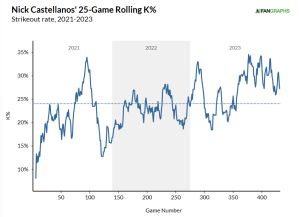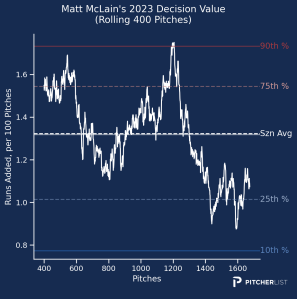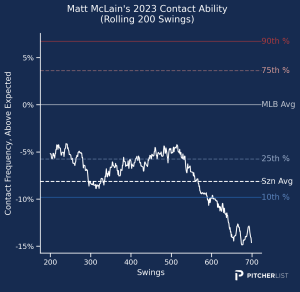Tier 8
61. William Contreras (C, MIL) – Seeing the strikeout rate drop to 20.6% in 2023 was a good sign, as the 29.3% and 27.7% he posted in 2021 and 2022 were big red flags that indicated there might be a low floor. Contreras only hit 19 home runs in his 141 games after hitting 28 in his 149 games across 2021 and 2022, and that’s largely due to his extreme ground ball tendencies as his 55.0% groundball rate was the third highest in the league among qualified hitters. There’s 25 home run power here if he can bring that number below 50%, if not more, and the Brewers seem committed to playing him every day. I think some will place Contreras at the top of their catcher rankings or projections based on the upside, and I wouldn’t blame you for it. These top catchers are tough to separate.
62. Anthony Santander (OF, BAL) – Santander is unlikely to surprise us in 2024, but the improved Baltimore offense means his 30 home runs and .250 batting average should come with close to 100 RBI. He won’t steal many bases, but his floor and ceiling are pretty close together, making Santander an excellent choice for those who have already taken a few gambles on offense.
63. CJ Abrams (SS, WAS) – For some reason, it took three full months before Washington realized that Abrams could steal bases and should maybe lead off for the Nationals. He stole just nine bags through the end of June, but after being promoted to the leadoff role in early July, he stole 16 bases that month, then 13 in August, and then nine more in September. Abrams has always been excellent at making contact, and in 2023 we finally saw some improvements in his decision-making ability. Abrams’ quick bat and aggression will always keep him from being an elite decision-maker by our metrics, but as long as he continues to make 90th-percentile contact, there’s a path toward 20 home runs and 50 stolen bases. The ratios will stink because he pops out a fair bit and tries to put too many balls in play, but his mix of power and speed will push him up a lot of boards as folks hope that the big spike in steal attempts sticks around.
By the way, this ranking is for his head-to-head categories value, which is highly variable based on your specific need for steals. He’s inside the top 50 in roto leagues as the volatility of steals has less of an impact.
64. Nick Castellanos (OF, PHI) – The strikeout rate went up fairly significantly (27.6%), continuing a trend that’s been going on for the last few seasons, but the production returned after Castellanos’s deeply disappointing 2022. There were ups and downs in 2023 (like May and July) that will make the floor a little bit scary, but the power is still there and he’ll continue to play every day for the Phillies so strong counting stats and 25 or more home runs should be there even if the batting average takes a tumble due to the strikeouts and inconsistency.

65. Nathaniel Lowe (1B, TEX) – The home runs and ratios went back to their 2021 levels, but on the plus side, so did the walk rate. Lowe should keep batting in the heart of the Texas lineup and get plenty of runs scored and RBI to go with 17-20 home runs and a .265 batting average. Those in OBP and points formats can probably move him up to the bottom of the previous tier due to the walks. It may not be exciting, but the steady and solid production Lowe provides should be more than enough to finish inside the top 80 hitters as he did in 2023, even without the big power we saw in 2022.
66. Matt McLain (2B/SS, CIN) – McLain won’t repeat his .290 batting average without a lot of batted ball luck (he’s not the type of hitter who can hit almost 25% line drives like he did in 2023), but there’s a good enough power and speed combo to give McLain a shot at 20-25 home runs and 15-20 steals for the Reds along with above-average counting stats. The decision-making and contact ability were progressing in the wrong direction, which raises some alarm bells, but to me that gets offset by the strong debut last season, at least to some degree. It’s also why I’m much lower on him than his current NFBC ADP.


67. Teoscar Hernández (OF, LAD) – It was a bumpy ride at times, but the free-swinging Hernández hit his way into a solid season in Seattle that saw him finish as a top 25 fantasy outfielder and top 60 fantasy hitter. Teoscar’s aggressive approach leaves him incredibly prone to hot and cold streaks, and those streaks defined his 2023 for me as he repeatedly oscillated between being a must-start and a must-sit sort of player.
Landing in Los Angeles with the Dodgers is an improvement in virtually every way—Dodger Stadium is extremely friendly to right-handed power (126 home run factor is tied with Great American Ballpark for the highest in baseball), and even though he’ll hit considerably lower in the order than he did in Seattle, Teoscar should have no issue getting to yet another 90 RBI season. Batting seventh makes it hard to score a bunch of runs, but we saw guys like Rosario and Ozuna bat in the bottom half of the order for much of the season and they showed it’s possible to get to 75 runs down there given enough playing time in a bombastic offense.
68. Jorge Soler (OF, FA) – It was Soler’s best season since the rabbit-ball era of 2019 thanks to good health, a career-high fly ball rate, a significantly reduced pop-up rate, and one of the best season-long strikeout rates of his career. Soler continues to hit the ball exceptionally hard on a very consistent basis, so he’s certain to find a team that wants him to play every day.
The keys to Soler’s 2024 will likely be team context (ballpark, supporting cast, etc.) and whether he can stay healthy after missing huge chunks of time in multiple prior seasons. If Soler wasn’t heading into his age-32 season with a long injury history, I’d likely have Soler at least one or two tiers higher than this. He could also jump if he signs with a powerful offense (like the Dodgers).
69. Brandon Nimmo (OF, NYM) –Nimmo finished just inside the top 70 hitters last season thanks to a significant power boost tied to an elevated fly ball rate and also a career-high in plate appearances. He hit the ball harder as well, raising his average exit velocity by over two ticks. There’s still some risk on the injury front as Nimmo enters his age-31 season having missed significant time in 2017, 2019, and 2021, but if you believe the almost one-to-one ground ball to fly ball rate will stick in 2024, then Nimmo should be moved up a tier. I’m a bit skeptical about that, but not so skeptical that I’m uninterested in Nimmo in 12-team leagues.
70. George Springer (OF, TOR) – Springer just put up his first ever 20-20 season at age 33, and while durability and age are negative factors to his value, he did put up a second consecutive season with at least 133 games and has at least 20 home runs in each of his last seven full seasons (even his injury-shortened 78-game season in 2021). Springer will be on top of a Blue Jays lineup that disappointed in 2023 and should rebound in 2024. 25 home runs, 15 stolen bases, and a .250-.260 batting average feel like a good baseline if he plays a full season, despite his advanced age.
71. Seiya Suzuki (OF, CHC) – Suzuki is now two-for-two in slow starts and strong finishes here in the US, and in each case, we have at least a somewhat compelling reason for the slow start (adapting to the US in 2022, and coming back from injury in 2023). A Suzuki that doesn’t start poorly and stays healthy could probably hit 25 home runs, steal 10 bases, and slash .280/.360/.485, and I’m willing to buy into that upside at least one more time.
72. Luis Arraez (2B, MIA) – Arraez is at his best in points leagues where you get credit for all of those singles even if they don’t drive anyone in, but 80 runs scored and 60-70 RBI with a batting average that can be anywhere from .310 to .350 has value even when it comes with no speed and only 10 home runs. Arraez isn’t a fit for every team build, though. For example, if you’ve already drafted three or four hitters who are likely to hit .280 or better, Arraez’s impact to your bottom line may not quite be worth a pick in this range. If you instead took a few guys who either will or could tank your batting average (De La Cruz or Schwarber come to mind), Arraez can move the needle significantly due to the number of plate appearances he should get every week and the fact that he’s the odds-on favorite to win the NL batting title.
73. Willson Contreras (C, STL) – After a rocky start in St. Louis, Contreras hit 20 home runs and chipped in over 120 combined runs and RBI for the fourth time in as many 162-game seasons. I see no reason Contreras can’t do that again, and that kind of floor is extremely rare at catcher.
Tier 9
74. Marcell Ozuna (UT, ATL) – Ozuna set career highs in home runs and RBI while also raising his batting average by over 50 points from 2021 and 2022. It’s an extreme change after looking like he was toast for two seasons, and it’s not easy to explain using pure statistics. Ozuna’s health has been an issue in recent years, but the upside of a healthy and slugging Ozuna in Atlanta’s lineup is hard to ignore.
75. Andrés Giménez (2B, CLE) – Like many Guardians, Giménez got off to a slow start in 2023, particularly in the power department as he hit just three home runs in his first 61 games along with way too many grounders and pop-ups. Following that skid, things did pick up as Giménez hit 12 home runs and stole 23 bases over the remaining 92 games, which would have been a 20 home run, 40 stolen pace over 162 games.
I don’t buy into Giménez hitting 20 home runs with any regularity, but 15 is a reasonable baseline, and 30-40 steals in the current environment are also repeatable thanks to his aggressive manager. There also should be improved counting stats in 2024 as he cements his role as the number two hitter in front of Ramirez and Naylor, and that will help him return more value in 2024.
I realize I’ve used 162-game averages a few times so far in this article, but please don’t mistake that as a way to project a player. Instead, it is a way to put smaller samples into an easy-to-compare context to highlight just how good or bad the sample would have looked over a full season.
76. Yainer Diaz (C, HOU) – With the manager already declaring Diaz as the head backstop heading into 2024, Diaz has the potential to finish as a top-five catcher thanks to his blend of hit tool, power, and opportunity. It wouldn’t take much for Diaz to hit within the top five spots in the order for the Astros (Roster Resource has him sixth, with Abreu in front of him), and even if he only plays in 110-120 games, Diaz could approach 25 home runs and 75 RBI. Diaz’s quality of contact data from Statcast supports the high batting average we saw. This combination of talent and situation has me placing Diaz in a tier of his own at catcher and as my clear number five.
77. Salvador Perez (C/1B, KCR) – Perez is a two-category catcher at this phase of his career as he provides home runs and RBI with extreme reliability as he tries not to hurt you in runs scored and batting average. His 22-25 home runs and 70-80 RBI are about as bankable as they come if he plays at least 120 games, though at some point we have to wonder when the extreme mileage on Sal’s tires start to impact his ability. His barrel rate, hard-hit rate, and average exit velocity were down from his 2021-2022 numbers, but they were still in line with numbers from before that stretch so I don’t think we should be concerned yet.
78. Bryson Stott (2B, PHI) – The spray-hitting second baseman broke out in a big way in 2023 by hitting 15 home runs and stealing 31 bases with a high batting average for the Phillies. He finished as the 60th-best hitter for fantasy purposes in standard leagues, though I’m not sure he can be quite so successful in 2024. The 15 home runs seem about right, but the 31 stolen bases are more than he had in his entire career up until 2023. The new rules give players a boost, but this was a little extreme. I’m envisioning something closer to 20 steals (which is still a big jump from his previous single-season record of 14). Put that together with good ratios (.270 average with a .325 OBP, perhaps?), and you have a hitter who is definitely in the top 100 and has a shot at approaching the top 50.
79. Lane Thomas (OF, WAS) – Thomas exceeded my expectations for him in just about every category, and in the case of home runs and steals, he did it by almost double. While his quality of contact did improve to a degree and he did start pulling the ball significantly more, it doesn’t explain the improved numbers. If it did, our Pitcher List expected stats (which take into account batted ball direction) would show something better than a .237 xAVG and .446 xSLG. While I do think a 20-20 season is within reach and accept that none of his numbers seem especially dubious, I’m still a bit skeptical that Lane Thomas can wind up in the top-50 hitters. Top 60 or top 75 should be doable, though, and his floor should keep him from falling out of the top 100 (which is not true for many hitters in the tier below).
80. Riley Greene (OF, DET) – Greene’s injury, which forced him to miss more than a month of action, could not have come at a worse time as he was absolutely on fire at the time, hitting .365/.435/.573 last May before going down. Greene’s power and speed aren’t overwhelming for fantasy, but I still believe he can get to 20 home runs and double-digit steals with an excellent batting average if he stays healthy with the upside to do even more.
